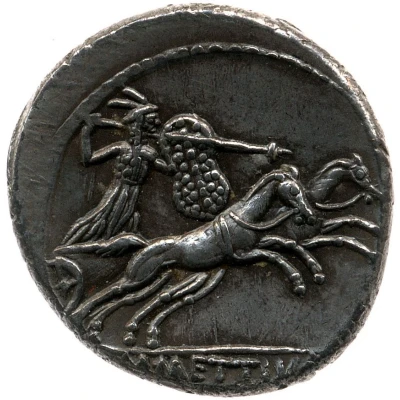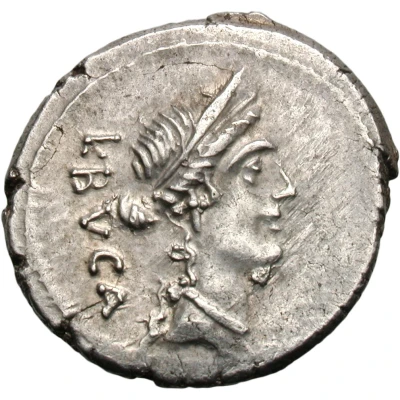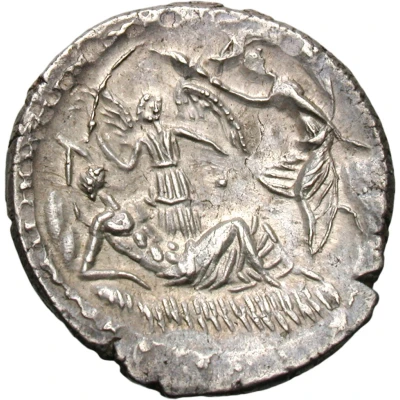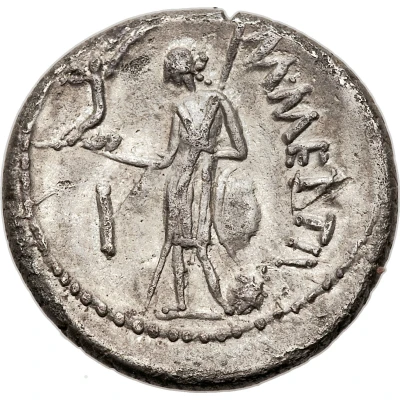


© British Museum
Denarius - Julius Caesar M•METTIVS; Rome 44 BC
44 BC year| Silver | 3.55 g | 17 mm |
| Issuer | Rome › Roman Republic (509 BC - 27 BC) |
|---|---|
| Period | Republic (509 BC - 27 BC) |
| Dictator | Julius Caesar (Caius Iulius Caesar) (49, 47, 46-44 BC) |
| Type | Standard circulation coin |
| Year | 44 BC |
| Value | Denarius (1) |
| Currency | Denarius of 16 Asses (141 – 27 BC) |
| Composition | Silver |
| Weight | 3.55 g |
| Diameter | 17 mm |
| Shape | Round (irregular) |
| Technique | Hammered |
| Orientation | Variable alignment ↺ |
| Demonetized | Yes |
| Updated | 2024-10-06 |
| Numista | N#384157 |
|---|---|
| Rarity index | 100% |
Reverse
Juno Sospita in biga, right, holding reins and shield in left hand and spear in right hand. Border of dots.
Script: Latin
Lettering: M•METTIVS
Comment
The earliest portrait denarius of Julius Caesar.Early in 44 BC, the Roman Senate began heaping honor after honor upon Caesar, who, by this time, had vanquished all his political enemies, becoming the supreme master of the Roman state. One of the most radical innovations was the placement of his portrait on the Roman coinage, in the style of Hellenistic kings, the first time a living Roman would do so in Rome itself. While we do not know precisely how his contemporaries reacted to this brazen act, it undoubtedly contributed to the radicalization of certain segments of the traditionalist ruling elite which sought to remove Caesar from power.
This coin belongs to the very first issue of Caesar's portrait denarii, which are generally of superior style compared to later lifetime issues. Struck from just eight obverse dies, of which this is arguably the finest, the issue features a delightfully veristic portrait, displaying Caesar's characteristic scrawny neck and sagging skin, while the wreath is strategically placed to cover his growing baldness. This wreath is the corona aurea, a symbol of the triumphator, while behind the dictator's neck a lituus, the staff of an augur, is shown, reminding the viewer that Caesar was authorized to read omens and predict the future.
The obverse legend refers to Caesar's fourth dictatorship and thus clearly indicates this issue must antedate Caesar's coins carrying the title DICT(ator) PERPETVO. In contrast to the later issues, the reverse also does not yet show a type connected to Caesar, but rather one related to the moneyer, as Juno Sospita ('the Savior') was particularly venerated in Lanuvium, the ancestral home of the gens Mettia. She would soon be replaced by Venus Victrix, however, a first hint that the needs of the imperator would come to overshadow those of the moneyer, until the latter would disappear into the background entirely under the Empire.
RRC 480/2c; lituus curved to left; M•METTIVS below horses
@Bibliothèque nationale de France
Interesting fact
One interesting fact about the Denarius - Julius Caesar (M•METTIVS; Rome) coin is that it features a portrait of Julius Caesar, who was the first Roman general to be depicted on a coin, and this coin was minted during his lifetime, which was a rare occurrence in ancient Rome.



